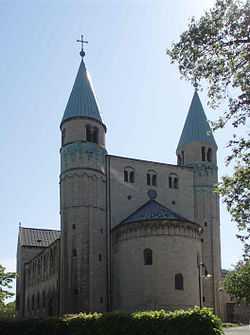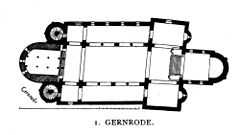St. Cyriakus, Gernrode

St. Cyriakus (German: Stiftskirche St. Cyriakus) is a medieval church in Gernrode, Saxony-Anhalt, Germany. It is one of the few surviving examples of Ottonian architecture, built in 969/960-965 by margrave Gero, although it was restored in the 19th century. It is now used by the Evangelical community of Gernrode.
History
Gero was one of the main collaborators of emperor Otto I, and had his residence in the castle of Gernrode. He decided to found the church in memory of his son Siegfreid, who had died heirless in 960, through a vast donation to a female convent. After Siegfreid's death, his widow Hathui became abbess of the monastery. The collegiate church of St. Cyriacus still contains the grave of Gero. Hathui was buried next to him in 1014.

Originally, the church was likely dedicated to St. Mary and St. Peter, but after the arrival of St. Cyriacus' relics, obtained by Gero himself in Rome around 950, it changed its name to the current one. Additions to the church in the 11th and 12th centuries, include the west crypt, side galleries, the enlargement of the Westwork and the towers and the two-storey cloisters. The vault of the transept were added in the Gothic period. The convent became an imperial abbey, with jurisdiction to a vast area including 23 villages.
After embracing the Protestant creed in 1523, from 1564 to 1606 the convent had only abbesses belonging to the local ruling House of Anhalt dynasty. The last abbess died in 1616. The abbey became a secular domain, although it kept the former privileges and jurisdiction, until it was sold to privates in 1831. In the 19th century the church was deconsecrated and used as a farmer store; most of the windows were thus closed. The crypt became a stable and a potato store. In 1858, thanks to the intervention of art historian Franz Theodor Kugler and historian Ludwig Puttrich, duke Leopold IV of Anhalt-Dessau ordered a restoration, which lasted until 1874. The exterior was partly modified, although the interior has maintained most of the original Ottonian appearance (with the exception of the paintings).
Description
The central body of the church has a nave and two aisles, surrounded by the eastern transept and the Westwork, which is sided by two towers. These elements, typical of the Carolingian architecture, were paired by novelties anticipating the Romanesque style: as the alternation of pillars and columns (a hallmark of numerous later churches in Saxony), the thick walls, the semi-blind arcades in galleries on the nave (similar to a triforium). The capitals of the columns show a variety of elements, with stylized leaves of acanthus and, in one case, human heads.
A chapel from about the 12th century in the southern aisle houses a late 11th century copy of the grave of Christ (a representation of the Holy Sepulchre in Jerusalem), which is one of the oldest of its kind in Germany.
| Wikimedia Commons has media related to Stiftskirche St. Cyriakus in Gernrode. |
Sources
- von Heinemann, O. (1877). Geschichte der Abtei und Beschreibung der Stiftskirche zu Gernrode. Quedlinburg.
External links
- Page at transromanica website (German) (English)
Coordinates: 51°43′27.30″N 11°8′9.50″E / 51.7242500°N 11.1359722°E